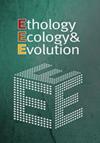Effect of supplemental feeding on habitat and crop selection by wild boar in Sweden
IF 1.3
4区 生物学
Q4 BEHAVIORAL SCIENCES
引用次数: 4
Abstract
The wild boar population has increased rapidly during the last 2 decades in Southern and Central Sweden. This rise in population size has caused severe damages to agricultural fields through their foraging behavior. Given the hierarchical nature of habitat and resource selection, wildlife management needs to understand the selection on both levels to better understand the ecology of nuisance species and mitigate the damages they infer. Thus, there is an urgent need for more knowledge on the factors that influence habitat selection as a tool in the evidence-based management of wild boar to reduce the losses they cause in the agricultural sector. This study aims to evaluate a common management action (feeding stations) influencing wild boar selection of (1) habitats and (2) resources i.e., crop types, in South-Central Sweden during summer. Eleven wild boars were fitted with GPS/GSM-collars to record movement among different habitats and crops. Wild boar shows a high preference for clear-cuts, agricultural fields, and deciduous forests. The animals showed a high preference for crop fields with oat, spring wheat, and mixed crops. A binary logistic model revealed both a positive and negative significant influence of distance to feeding stations on the selection of different habitats and crop fields. In general, feeding stations influenced the selection of different habitats and crops negatively i.e., the closer a habitat or crop field is to a feeding station, the higher the likelihood of its selection. The study recommends adjustments to wild boar management and cropping systems to reduce damages on highly selected crop fields.补饲对瑞典野猪生境和作物选择的影响
在过去的20年里,瑞典南部和中部的野猪数量迅速增加。这种种群规模的增加通过它们的觅食行为对农田造成了严重的破坏。考虑到栖息地和资源选择的层次性,野生动物管理需要了解这两个层面的选择,以更好地了解滋扰物种的生态并减轻它们所造成的损害。因此,迫切需要更多关于影响栖息地选择的因素的知识,作为野猪循证管理的工具,以减少它们在农业部门造成的损失。本研究旨在评估瑞典中南部夏季影响野猪选择(1)栖息地和(2)资源(即作物类型)的共同管理行动(喂食站)。研究人员给11只野猪安装了GPS/ gsm项圈,以记录它们在不同栖息地和农作物之间的活动。野猪对砍伐干净的土地、农田和落叶森林表现出高度的偏好。动物对种植燕麦、春小麦和混合作物的农田表现出高度的偏好。二元logistic模型分析表明,距离饵料站对不同生境和作物类型的选择均有正、负显著影响。一般来说,取食站对不同生境和作物的选择产生负向影响,即离取食站越近的生境或农田,其被选择的可能性越高。该研究建议调整野猪管理和种植制度,以减少对精选作物田的损害。
本文章由计算机程序翻译,如有差异,请以英文原文为准。
求助全文
约1分钟内获得全文
求助全文
来源期刊

Ethology Ecology & Evolution
生物-动物学
CiteScore
3.10
自引率
0.00%
发文量
44
审稿时长
>12 weeks
期刊介绍:
Ethology Ecology & Evolution is an international peer reviewed journal which publishes original research and review articles on all aspects of animal behaviour, ecology and evolution. Articles should emphasise the significance of the research for understanding the function, ecology, evolution or genetics of behaviour. Contributions are also sought on aspects of ethology, ecology, evolution and genetics relevant to conservation.
Research articles may be in the form of full length papers or short research reports. The Editor encourages the submission of short papers containing critical discussion of current issues in all the above areas. Monograph-length manuscripts on topics of major interest, as well as descriptions of new methods are welcome. A Forum, Letters to Editor and Book Reviews are also included. Special Issues are also occasionally published.
 求助内容:
求助内容: 应助结果提醒方式:
应助结果提醒方式:


